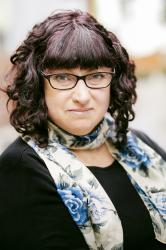Malthouse: Frankenstein
My uterus is still reacting to The Rabble’s Frankenstein.

I say it every time, but no one makes theatre like The Rabble does and Frankenstein is stretching their own boundaries far enough for Malthouse to include content warnings. Read them and you’ll know if you should give it a miss.
Working with their actors, co-creators Kate Davis and Emma Valente devise work based on well-know texts. Hours of improvisation and development never get near the stage (and they kept cutting after the previews). What’s left is distilled, clear and so potent that it’s not safe to take in more than sips.
The novel Frankenstein was written by an 18-year-old woman. In 1816 Mary Shelley was on holiday in Geneva with her new husband Percy (whose first wife had recently suicided), and writers Lord Byron and John Polidori. They had a competition to write the best horror story. Mary won with the beginnings of the novel that was first published anonymously in 1818 and in her name in 1823. It’s about a doctor who creates life: a monster who doesn’t want to be alone.
The Rabble tell it as a story about fertility and birth, knowing that between 1815 and 1818 Shelley lost three children at birth. Finally, one baby survived.
In this story, an infertile doctor (Mary Helen Sassman) wants to be a mummy so much that she’s going to fight until she makes a baby by any means possible, helped by her assistant (Dana Miltins) and adopted blind daughter (Emily Milledge). The return of her brother (David Paterson) makes for awkwardness, but not as awkward as the fact that she creates a monster (Jane Montgomery Griffiths).
With the horror-film monster often better known than the book, there’s as much reference to horror films as to the novel – especially those made to squeal and look away from and those that treat women atrociously.
The orange stage is alien and uncomfortably beautiful, and filled with hundreds of black water-filled balloons.
Like monster eggs, they are slippery and wobbly and range in size from a mensturating to a first-trimester uterus, which becomes squeal-and-look-away clear when the first is ripped open into a bucket.
This is reproduction that’s bleeding, empty, ripped, violent, invasive, torturous, stinking, screaming, agonising, helpless, stitched, scarred, violated, stretched and exhausted.
And it’s beautiful.
Blood and pain are such a part of making, or trying to make, new life and finding the exquisite love that’s swaddled in a soft bunny rug.

With an infertile naked mutant-breasted monster, a womb that never forgives its emptiness and one ripped out before it had a chance, Frankenstein’s honesty is confronting and Valente and Davis never hold back when a visual choice has to be made. Yes, it has to be a coat hanger and it has to be red globby jelly and it’s impossible to not see the difference between the naked flesh of a woman in her 20s and one in her 50s.
It’s extreme, but no more than the horror films inspired by Frankenstein. In comparison to some, it’s mild. And, as we laugh as much as squeal at horror films, it’s more than ok to laugh if it gets too much, too graphic or too close.
The Rabble’s monster story dares us to find beauty and laughter – and perhaps even comfort – in the horror of reproduction.
I just wish I’d had some ibuprofen with me.

